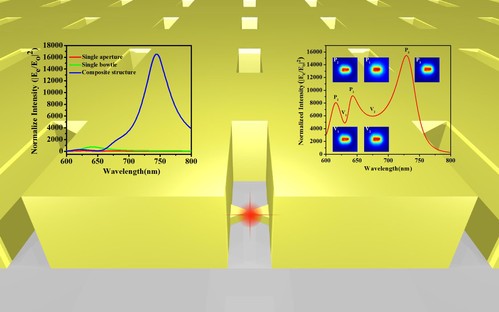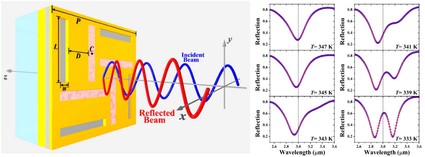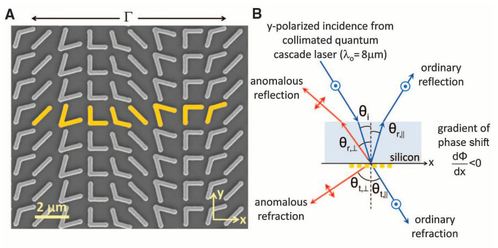Metamaterials, artificial composite structures with exotic material properties, have emerged as a new frontier of science involving physics, material science, engineering and chemistry. The property of a bulk material is essentially determined by the chemical elements and bonds in the material. People have never ceased from better understanding and controlling material properties. Most recent nanoscience and nano-technology aim to study the electronic, optical, thermal and mechanical property of materials starting from the atom- or molecule-level. All of these efforts have significantly expanded the range of materials accessible to people.
In the past decade, metamaterials offered an entirely new route to further enhance the capability of people to design material properties at will. The physical properties of metamaterials are not primarily dependent on the intrinsic properties of the chemical constituents, but rather on the internal, specific structures of metamaterials. These artificial structures function as atoms and molecules in traditional materials; while through regulated interactions with electromagnetic (EM) waves, they can produce fascinating physical properties such as negative index, invisible cloaks and illusion optics which are unavailable in naturally occurring or chemically synthesized materials. This is why such composite structures are termed metamaterials, which literally stand for materials beyond natural ones.
The rapidly growing metamaterials research is driven by a number of potential applications of metamaterials. Our researches mainly contain the applications in perfect absorption, manipulating nanoscale localized fields by composite metameterials, electromagnetically induced transparency (EIT), super-resolution imaging and so on.
1. Metamaterial Perfect Absorber
A particular branch-the metamaterial perfect absorber (MPA) has garnered interest due to the fact that it can achieve unity absorptivity of electromagnetic waves. Since its first experimental demonstration in 2008, the MPA has progressed significantly with designs shown across the electromagnetic spectrum, from microwave to optical. Electromagnetic (EM) wave absorbers can be categorized into two types: resonant absorbers and broadband absorbers. Resonant absorbers rely on the material interacting with the incident radiation in a resonant way at a specific frequency. Broadband absorbers generally rely on materials whose properties are frequency independent and therefore can absorb radiation over a large bandwidth. In addition to applications, there are many great options for future development of MPAs. One is the advent of tunable, or active, metamaterial absorbers, i.e. making a MPA that could be dynamically tuned by means of external stimuli.

2. Manipulating Polarization based on Graphene Metameterials
Optical activity, which was defined as the rotation of polarization of light after passing through circularly birefringent materials, has now been widely used in many areas like optics, analytical chemistry and molecular biology. The recently emerging concept of metamaterials, opens up the possibility to enhance and expand optical activity effects, surpassing that of natural birefringent and chiral materials. Especially, through specific structural and material design, a near-complete cross polarization conversion (CPC) has been achieved with metamaterials, such as multilayered metasurfaces, subwavelength metallic apertures and metallic cut wire arrays. It is worth noting that most such CPC metamaterials are narrowband and may only be tuned to different wavebands by carefully reoptimizing the geometry parameters owing to the reliance on resonances, which limit their uses in practice. we proposed a highly wavelength-tunable broadband CPC composed of a single patterned top layer with L-shaped graphene nanostructures, a dielectric spacer and a gold plane layer in the mid-IR regime. We demonstrate that the designed CPC can convert linearly polarized light to its cross polarization in the reflection mode. Moreover, the polarization conversion can be dynamically tuned and realize a broadband effect by varying the Fermi energy without reoptimizing and refabricating the nanostructures, which offers possible applications as tunable polarizers and polarization switchers.

3. Manipulating Nanoscale Localized Fields by Composite Metameterials
The ability of some metamaterials to confine light to the nanometer scale with high intensity is of great interest to studies of light interactions with biological materials and nanostructures as well as some potential applications such as nanolithography, fluorescence enhancement, and surface-enhanced Raman scattering. There are two kinds of nanosturecture: nanoantennas and nanoapertures, which can concentrate and enhance the optical near field. A central goal of these nanostructures is to provide an enabling technology for complete manipulation and control over optical radiation at deep subwavelength scales. This manipulation capability is mainly reflected in two aspects, namely spectral steering of the resonant wavelength and spatial manipulation of the optical field distribution. Our group proposes a periodic composite nanostructure consisting of Bowtie nanoantennas and asymmetric nanoapertures, which provides a new way of indirectly tuning the resonant wavelengths and manipulating the localized fields. This way overcomes the constraint of the mechanisms and improves the degree of freedom of operating the resonant wavelengths and steering optical field distributions.

4. Electromagnetically Induced Transparency
Another appealing topic associated with metamaterials is electromagnetically induced transparency (EIT), recently investigated by several groups. EIT was first discovered in atomic systems. In a three-level atomic EIT system, the coupling between the excited energy level with a dipole-allowed transition to the ground state and a metastable level by a control beam leads to a destructive interference. This destructive interference can render a transparent window within a broad absorption band. A meta-molecule consisting of one radiative or bright mode and one subradiative or dark mode can mimic an atomic EIT system. By carefully designing the strip geometries, the central resonance frequencies of the bright atom and the dark atom can be overlapped. Recently, we propose the design and analysis of a dynamically tunable PIT planar hybrid MM in a near-infrared regime, in which VO2 stripes are filled in the cut-out slots as components of a plasmonic system. Results show that the PIT effect of the hybrid MM can be agilely tuned by adjusting the temperature of VO2 stripes without modifying the structure accurately. This special embedded position of VO2 stripes will dramatically improve the dynamic modulation depth. Meanwhile, a four-level plasmonic system is employed to explain the PIT feature quantitatively, and the results agree well with the simulated results.

5. Super-resolution Imaging
Seeking the unprecedented ability of metamaterials to manipulate electromagnetic waves in a desired manner has continuously attracted enormous interest. A number of fascinating phenomena and applications, including negative index of refraction, invisibility cloaking, and flat lens beyond the diffraction limit, have been demonstrated through the ingenious design of metamaterials, challenging our cognitive limit to the electromagnetic responses of materials in nature. More inspiringly, new degrees of freedom were recently attained by introducing abrupt phase changes via two-dimensional (2D) metamaterials. Such metasurface is capable of generating a wide range of position-dependent discontinuous interfacial phase profiles for the outgoing electromagnetic wave with polarization orthogonal to the incidence. Since an abrupt phase shift over the wavelength scale can be introduced, the relationship between the incident and refracted beams seems beyond the standard Snell’s law. By simply engineering the metamaterial induced phase profile, a nearly arbitrary wavefront would be achieved. Compared to conventional optical components that rely on gradual phase accumulation to shape the wavefront, the unique approach of an abrupt phase change utilizing a flat metasurface promises nteresting device applications beyond the scope of conventional components.




